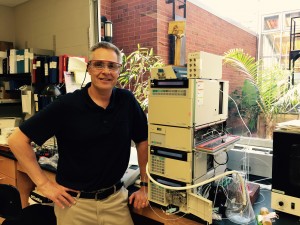sabbatical (n): a break from customary work to acquire new skills or knowledge, traditionally occurring every seventh year
Breaks Away: Sabbatical Stories of Hope
Each academic year, a number of Hope faculty take sabbatical leaves away from the college, submersing themselves for extended periods of time into their favored fields of inquiry. If viewed from above and all together, those fields would look like a calico landscape, so varied and colorful is the topography of their collective research, writing, and creative pursuits. Offering both restoration and adventure, sabbaticals are a bit like information and imagination transfusions. These breaks away from normal classroom and committee work give Hope academicians a boost to reinforce and revitalize their teaching and scholarship.
Whether in the field at the Michigan-based AuSable Institute of Environmental Studies (AIES), or in a lab at the prestigious Oak Ridge National Laboratory (ORNL), or in the classroom of a Great Lakes Colleges Association (GLCA) interdisciplinary program, Dr. Jonathan Peterson spent much of his year-long sabbatical in 2014-15 fully convinced of this:
Things in life are interesting and important to the degree that they relate to other things because, basically, most things in life—ideas and people—are connected, if not immediately then eventually. This credo makes sense to him back at Hope, too. The interdependence of subjects and people on each other is a fundamental aspect of a Christian, liberal arts education, after all.

Peterson, the Lavern and Betty DePree VanKley Professor of the Geology and Environmental Science, and a firm believer that all life-matters are interrelated, likes it that way.
“Taken all together, my entire sabbatical was rejuvenating as a Christian and a scholar because those two things are not separate, just as most things in life are not separate. Most everything goes together in practice and not just theory,” says Peterson. “I was called to be a Christian scholar in two different places (AIES and ORNL) last year, and I’m called to be both here at Hope.”
“Taken all together, my entire sabbatical was rejuvenating as a Christian and a scholar because those two things are not separate, just as most things in life are not separate. Most everything goes together in practice and not just theory.”
Two AuSable teaching experiences during the summers of 2014 and 2015 bookended Peterson’s full-year sabbatical leave, with his time at Oak Ridge in the middle. Located in Mancelona, Michigan, and supported by a consortium of Christian colleges, AIES is both field-based and faith-based as teachers and students investigate matters of environmental consequence with a Christian perspective. “Students and staff at AuSable are passionate about Christian environmentalism,” Peterson says. “It is a place that connects science and faith with themes of stewardship and conservationism in caring for God’s world.”
At ORNL, Peterson’s break-away shifted to intense research. Though he was the resident director of the GLCA Oak Ridge Science Semester in the fall, he conducted his own research for the full academic year, too, using cutting edge technology at a world-class facility while collaborating with world-class scientists. ORNL, first established in the early 1940s as part of the U.S. government’s Manhattan Project, is the Department of Energy’s largest facility conducting research to find “transformative solutions to compelling problems in energy and security.” Research productivity is critical there as individual ORNL scientists—well over 3,000 in more than 100 disciplines—published their findings six to eight times each year.
Peterson’s research analyzes how antibiotics breakdown in the presence of titanium oxide nano-particles. In and of itself, this could seem like a subject highly obscure and literally minute. Yet, it is the interrelated effects of these nano-particles and drug contaminants in our environment that may have implications for human health and medicine. Very small amounts of antibiotics are present in natural waters, Peterson points out, originating in part from the livestock industry and sewage treatment plants.
“And titanium oxide nano-particles are also present and are very reactive and very small. They are used in all kinds of products— sunscreens, cosmetics, paints, adhesives, tire treads, even powdered sugar donuts. That is how they enter the environment,” explains Peterson. “I want to know how the nano-particles break down the drugs or transport them in the water.”
Because here is his research’s interconnected bottom-line toward the greater good: The fate of these antibiotics in the environment is a key piece of information toward understanding the spread of antibiotic resistance in human and veterinary medicine.
So far, results from the research show that titanium oxide nano-particles interact with drugs in a variety of different ways. Some antibiotics undergo significant degradation while other break into fragments. Some of those fragments are transported by the nano-particles, and other are destroyed. “These results are significant,” says Peterson. “The next step is to determine the rate, or time, it takes for the interactions to occur.”
“Being at a place like Oak Ridge helped me be flexible and morph quickly as a teacher and a scientist,” continues Peterson, whose manuscript on this research was published recently in Science of the Total Environment. “Sabbaticals are good lessons to not become too entrenched. There are pressing matters that need results. I was privilege to be given the time and space to look into them.”
One related to the other, the other related to the one—this is how our world and its people work, from the smallest scientific particle to the largest Christian principle. That’s something Dr. Peterson has always related to.
—
Dr. Jonathan Peterson is the Lavern and Betty DePree VanKley Professor of the Geology and Environmental Science in Geological and Environmental Sciences Department at Hope College.

